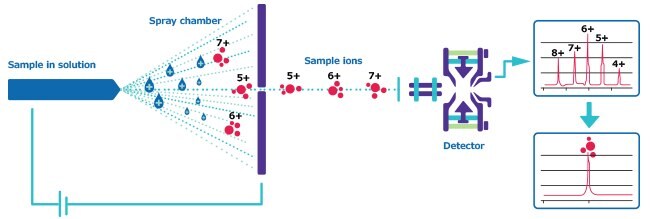Two types of MS are utilized to accomplish our commitment to 100% quality control: MALDI-TOF MS (matrix-assisted laser desorption/ionization-time of flight) and ESI-MS (electrospray ionization). Each type has advantages and disadvantages. Our different manufacturing sites use either one or both types of instruments depending on the nature of the sequences that are predominantly synthesized
MALDI-TOF MS
MALDI-TOF MS uses laser light in conjunction with a chemical matrix to ionize the sample and then accelerates the ions through a flight tube to the detector, which measures particle counts as a function of time (Figure 1). The TOF is directly proportional to the mass of the molecule and has a resolution of approximately 0.03%; i.e., +/- 3 Da on a 10 kDa oligonucleotide.

Figure 1.MALDI-TOF MS operates via a laser.
MALDI-TOF MS is ideally suited for for high throughput requirements, e.g. basic PCR primers, when speed of shipment is essential. Though a powerful and efficient technology to characterize oligonucleotides of lengths below 50 bases, MALDI-TOF MS has the disadvantage that the ionization efficiency, and therefore the resolution of the procedure, decreases rapidly for sequences greater than 50 bases (>13 kDa). Furthermore, the laser source used to generate the charge could be detrimental to the analysis of modified oligonucleotides that are photosensitive. ESI-MS can be utilized to bypass these limitations.
ESI-MS
Applications requiring oligonucleotides greater than 50 bases, e.g. gene synthesis, have increased the need for instrumentation that can accurately characterize these molecules. The method of choice for these oligonucleotides is ESI-MS (Figure 2). The target molecules are ionized into multiple charge states, producing a waveform that can be deconvoluted into parent peaks. As only the charge state will vary for the ions, oligonucleotides with high molecular weights can be analyzed using this method. Additionally, the inherently milder ionization conditions make this analytical technique a great tool for the analysis of labile compounds, e.g. reporter and quencher dyes used in Dual-Labeled Probes. The ESI-MS systems also have mass resolution of approximately 0.03%, i.e., +/- 3 Da on a 10 kDa oligonucleotide. For a comparison of passing and failing ESI-MS spectra, Figure 3. For a comparison of MALDI-TOF vs. ESI, Table 1.

Figure 2.ESI-MS operates via a spray chamber.

Figure 3. A comparison of passing and failing MS spectra.Mass is on the x-axis.
Conclusion
We use either MALDI-TOF or ESI-MS mass spectrometry to assess every oligonucleotide. If additional help is needed, please consult our technical services group at oligotechserv@sial.com.
Per continuare a leggere, autenticati o crea un account.
Non hai un Account?